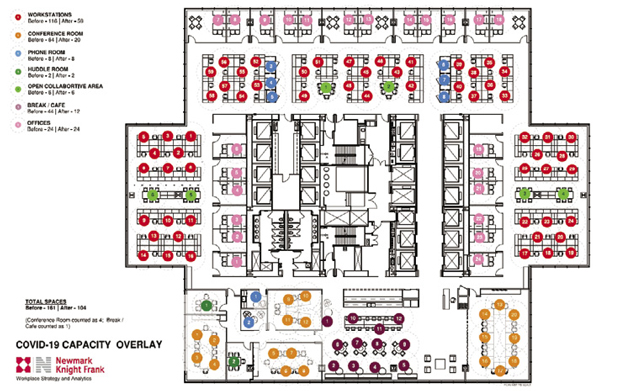 Neil McLocklin, Head of Strategic Consultancy, Knight Frank on the development of a roadmap to how businesses can prepare to go back to the office
Neil McLocklin, Head of Strategic Consultancy, Knight Frank on the development of a roadmap to how businesses can prepare to go back to the office
Pro-longed working from home has been a challenge for many. There is an enormous desire to get back to the office, as we realise the social importance of the workplace, and the ease of doing business and collaborating with colleagues that it facilitates.
The government has outlined a roadmap for when we can start to return to the workplace, starting with those who can’t operate from home. However, the message is clear – the approach must be phased and carefully planned, otherwise we risk losing all the gains we have made in defeating the virus.
The question for businesses is how to re-occupy workplaces in an effective and safe way, which ensures staff have the confidence and trust to return and aligns with the government’s goals. We have already witnessed staff and union resistance to a limited return back to the office by the UK Passports Office . It is certainly not as simple as announcing “Everybody back next Monday”.
In response to this we have set out a five-step process to follow, which we have developed through collaboration across the Newmark Knight Frank network, learning from colleagues in Asia. We have also been part of the UK Government consultation process.
TALK TO YOUR LANDLORD
This is the first step because it is outside your control. A safe working environment needs to be developed in partnership with the landlord, whether it is ensuring that they are changing the air conditioning filters, re-programming the lifts to ensure no more than a social-distanced restricted number of people can use them, or providing signage and sanitation in the entrance. Many landlords are being pro-active but others are still waking up to their responsibilities in this area.
REVIEW EMPLOYEE JOURNEY
We must also review the employee journey from home to the office, and the from the door to the desk within the building, assessing the risks along the way. Whilst the travel to work may not be considered the employers responsibility, the government is asking businesses to help mitigate the risks of over burdening the public transport network. This is largely taking the guise of encouraging staff to cycle and providing appropriate facilities, or staggering journeys, there are ways that businesses can support. A risk assessment of all the areas within the building will identify high risk areas that would include receptions, kitchen areas, meeting spaces, printer hubs, and showers just to name a few. Cleaning regimes, social distancing measures and protocols need to be developed in each of these areas to mitigate risk.
SOCIAL DISTANCING
It is necessary to review the workplace using the two metre social distancing rules, and not use desks that are within this distance. Check-boarding the occupancy ensures that staff are not sat opposite and facing each other. Best practice then is to remove the chairs form the workstations that are not within this distance. Other spaces such as small meetings rooms that can no longer be used with the two metre constraint, can be re-purposed as work space. An example of a capacity over lay can be seen below.
SUPPLIES PROCUREMENT
Once you have completed risk and capacity overlay then you will know what to procure, whether it is signage, masks or sanitisers, as well as how you need to re-specify the cleaning regimes.
DEVELOP PROTOCOLS
There are many areas where new protocols need to be developed and others reinforced strictly, such as clear desk policy, to enable effective cleaning of the workstation.
Examples include:
- Meetings – these should be avoided unless essential
- Printing – should also be avoided as printers are a high-risk area, not only in terms of direct virus transmission but also the documents that are produced are another source of risk
- Encourage people to bring in their own food
- Do not share equipment of any type – keyboards, mice, headsets
- Continue to wash hands regularly and for 20 seconds at a time
These protocols should be developed as strict rules to follow.
AFTER CORONAVIRUS WORLD
The government is advising that social distancing should continue beyond the return to work, and some recent research from Harvard University has suggested social distancing could continue until 2022. We need to plan for an extended period of this ‘new normal’ and ensure it is managed as a change programme in its own right.
Many companies are training Return to Work champions to ensure understanding and compliance with the protocols. The new office will be a strange place to work and one of the challenges will be how to bring some fun and social element into the workplace. In the same way that we have been innovative in how we shifted to work from home, we will need to be creative in how to make the new workplace enjoyable. In addition, the blend of extended working from home alongside children being allowed to go back to school, and combined with some work in the office will be another continuation of this experiment. We will be able to determine how we want to and need to work in the future and develop the after Coronavirus workplace that best suits our needs.





